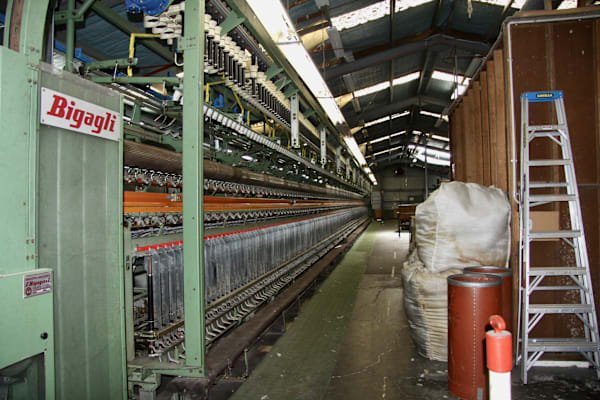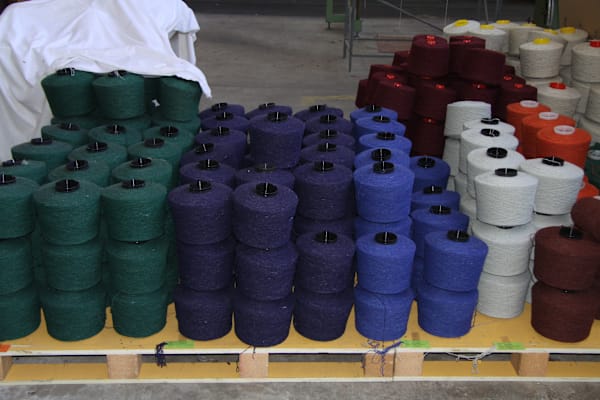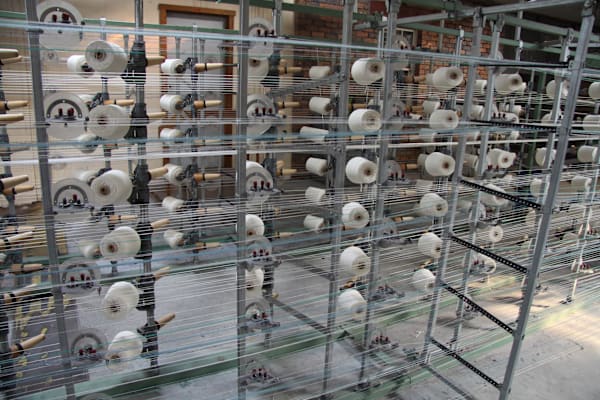On the outskirts of Launceston, tucked amongst the leafy overgrowth at the end of a quiet road, sits a collection of red brick buildings and corrugated iron sheds. This is Waverley Mills which, at almost 150 years old, is the oldest woollen mill still operating in Australia.
The site is tidy but quiet on this chilly day, without sounds from machinery or machine operators. The brick stack towering behind stands smoke-free.
Inside, the office feels colder than the sunny carpark and two women work at their computers rugged up in jackets and fingerless gloves. Framed photographs on the wall offer a glimpse of a busier time, with horse-drawn carts loaded high with bales of wool and groups of solemn men.
In its heyday, Waverley produced 80 per cent of the woollen blankets in Australia and exported the product around the world. The place was humming and steady work supported 300 workers and their families. Onsite housing was used as a perk to attract senior managers and skilled professionals from afar.

Now, the sheds at Waverley are quiet more often than not. Twenty years ago the company employed 120 staff, then half that a decade later and now only 20, a third of whom are casuals. The onsite housing has been sold, no longer required for professionals that don’t come.
Throughout the second half of the 20th century a series of challenges crippled the manufacturing sector in Australia, buffeting companies like Waverley in the process. Tariff reductions, rising wool prices and increased labour costs have made the industry less profitable. At the same time, the wider use of cheaper synthetic fibres, the increasing popularity of electric blankets, and the adoption of central heating and more energy efficient housing mean that woollen products are no longer as popular as they once were.
Waverley has struggled to stay afloat.
It went into administration in 2005, leading to the loss of a major contract supplying blankets to Qantas, and had to shed half its workforce as a result. Further staff cuts over the following few years reduced the company to a skeleton of what it once was.
Still, Waverley fights on and is now the last of its kind. Several other woollen mills once operated in Launceston but all have now closed. As the last man standing, Waverley finds itself holding the title of oldest fully functioning wool mill in Australia. It is also now the only one in the southern hemisphere that weaves from the raw fibre through to the final product.

. . .
As I walk around the mill with retail manager Penny Rundle, she explains that this survival has been possible, in part, to the willingness of the company to adopt new strategies. Waverley pioneered the use of hydroelectricity in 1889, five years before power arrived in Launceston, and was a forerunner in the development of the electric blanket. At the start of World War II, the mill dedicated itself to producing grey standard-issue blankets for the armed services. More recently it started an innovative recycling program, mixing old jeans and school blazers with wool and synthetics to create throw rugs.
At the same time, Waverley has maintained its traditional techniques and high standards of quality. It produces mainly blankets and throw rugs, products that face competition from the increasingly popular continental quilt. Rundle is confident that adherence to quality will overcome challenges like this, pointing out that woollen blankets can last decades, far longer than the average quilt.
Nevertheless, blanket sales are seasonal, with a peak in winter. The contract with Qantas helped to balance this through the rest of the year, and without it the mill has struggled to fill the gap.
In 2017, the company launched a crowdfunding campaign aimed at fixing ageing infrastructure and buying raw product. This would guarantee enough stock for orders to be filled, and secure four months’ work for employees in the process. The measure of community support for the mill was shown when the target of $90,000 was smashed and closer to $160,000 was raised. The extra allowed the mill to buy more raw product and eased the pressures generally.

However, as innovative as Waverley would like to be, it is held back by inherent issues with old equipment, limited capacity for big orders and trouble finding staff.
Head weaver Andrew Monaghan explained that the maintenance of old, increasingly rare machines is the mill’s biggest challenge and that “when something breaks down it holds everything else up”. This often requires engineers and technicians with specific skills to be engaged, or for parts to be ordered from Europe. Professionals with knowledge of the machines at Waverley are increasingly difficult to find. Recently, an issue in the carding machine took two weeks to “patch”.
“That’s what we’re doing,” Monaghan says. “Patching up, band-aiding.”
The newest machine in the mill is almost 20 years old while the oldest, a raising machine imported from England, is more than 100 years old. Monaghan tells me that a German weaver in his 80s was amazed on a recent visit that the older machines were still working.
This hodgepodge of ages is on clear display inside the mill, with mid-19th century brickwork and rust-stained pipes framing the mid-20th century equipment.

. . .
Like the machines they operate, several of the workers at Waverley have been there for decades. Many are approaching retirement age and are keen to pass on their skills to ensure the future of the mill. However, few people today are interested in joining an industry that is manual, low paid and under threat. The ongoing decline of the manufacturing sector since the mid-20th century means that “there are few people left in Australia with the skills to work the machines”, says Monaghan. The pool from which to source staff is continually shrinking.
These inherent problems mean that the mill is restricted from taking on large orders at short notice. When a Waverley blanket was gifted by the Australian Government to baby Princess Charlotte in 2015, the resulting wave of publicity lasted two or three weeks but came at a time when the company had very little warehouse stock and no capacity to expand quickly.
Despite these problems, Rundle tells me that the appointment of CEO Andrew Cuccurullo breathed new life into the company.
“My role is to grow Waverley as a brand, making our products the best they can be and relevant to a new set of people who may not have considered Waverley before,” says Cuccurullo
By encouraging the company to build strong links with the local design, education and tourism sectors, he is confident that investment and partnership opportunities will follow.
“We are looking at … upgrading some of the buildings with a café and shop, and providing other activities that will happen on the grounds,” says Cuccurullo. “We are also bringing schools to the mill and working with the Architecture and Design Department at UTAS.”

Indeed, amidst the near-silence of the site I start to hear voices and it becomes evident that a tour of the mill is underway. A dozen or so 20-somethings, who I later learn are fashion design students, file past me and into the gift shop. They linger over the products, touching the textures one by one before making their purchases and drifting away to their cars, hopefully full of inspiration from their Waverley experience.
Both Andrew Cuccurullo and Penny Rundle seem optimistic about the future of Waverley.
“The threats to Waverley are the same as most manufacturing entities,” says Cuccurullo, “but amplified a little because the mill is old and our equipment isn’t modern. Getting parts or skilled labour to fix these older machines can be sometimes difficult. The flip side to this is the product produced is unique and specific to Waverley because of this older equipment.”This is a sentiment that Rundle shares, asserting that investors were right to “have faith that there would be interest in the product.” For her, Waverley’s survival is “a collaborative effort of people who have dedicated their life skills to the mill.”
With that type of team effort and confidence behind it, there is little wonder that Waverley has endured so long.
Grace Heathcote is a Tasmanian freelance writer. After a childhood spent exploring the forests and beaches of Tasmania, she left the island in 2007 to study, work, and travel through Australia and overseas. The charm of Tasmania lured her home in 2014 and has continued to weave its magic for her ever since.







